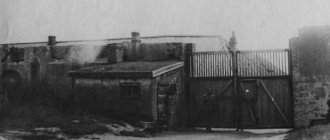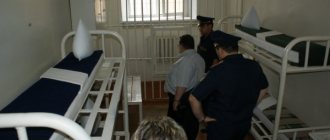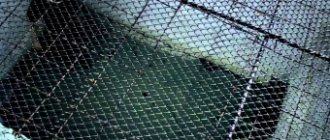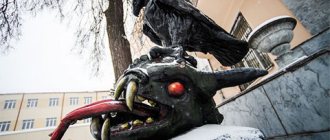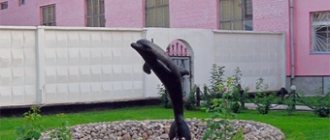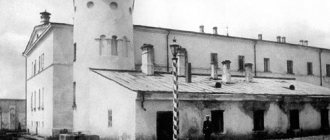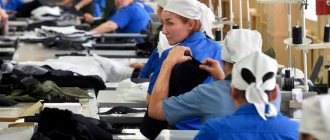Lenta.ru begins a series of publications about special regime colonies - the most terrible zones in Russia. There, in extremely harsh conditions, the most dangerous criminals are serving life sentences - from maniacs and cannibals to terrorists and creators of criminal gangs. Our first story is about the Black Dolphin colony in the Orenburg region, the largest special regime zone, which dates back to the 17th century. The prisoners live here under round-the-clock surveillance; each of them is taken out for walks by a whole detachment of jailers, and so that no one even tries to escape, black bags are placed over their heads. For their terrible crimes, these prisoners will remain in the Black Dolphin until the end of their days.
From drunkards to maniacs
In 1905, the Iletsk prison department was transformed into a transit prison and it operated in this mode until the 1917 revolution. With the arrival of the Bolsheviks and until 1942, the institution was called the Iletsk concentration camp. Deserters, White Guard accomplices from the civilian population and military personnel caught drunk were kept there. Some of them managed to atone for their guilt by high-quality repairs of the prison building: after its completion, in 1919, the first batch of prisoners was amnestied.
In those years, those who did not pose any particular danger - deserters, idle alcoholics and speculators - were sent to the Iletsk camp. The conditions of detention were very humane: prisoners ate the same as the jailers and could go outside the institution. But over time, more serious contingents began to be brought to Iletsk: cadets from Kolchak’s army or prisoners of war in the Soviet-Polish War of 1919-1921. Of course, they no longer had soft conditions - and soon the Iletsk prisoners were again involved in salt mining.
Photo: “Orenburg POLITICS”
In 1942, the status of the correctional institution changed again: now it was called the Sol-Iletsk prison of the NKVD No. 2 for the detention of persons under investigation. In 1953, it moved to the Ministry of Internal Affairs, and in 1965 it became a refuge exclusively for convicts suffering from an open form of tuberculosis.
“Black Dolphin” received its current status as a special regime correctional colony, where prisoners sentenced to long terms up to life sentences are kept, only in 2000. Before the first batch of convicts was delivered to the territory of correctional colony (IK) No. 6 - this is the official name of the "Black Dolphin" - a major overhaul was carried out there and a modern tracking system was installed. In addition, the cells were equipped with additional bars at the entrance to enhance personnel safety.
The perimeter of the colony was also strengthened: additional checkpoints appeared there. In part, this measure was a response to the mass escape of 1967, when prisoners dug under the prison wall. And considering who is sitting in the Black Dolphin today, any escape from there poses a serious danger.
Fighting without rules (2017, UK, France)
Genre:
thriller, drama, adventure
Director:
Jean-Stéphane Sauveur (“Johnny Mad Dog”)
Script:
Billy Moore
Starring:
Joe Cole (“Peaky Blinders”), Vithaya Pansringarm, Pornchanok Mabklang
KinoPoisk:
6.4
IMDb:
6.9
A film adaptation of the memoirs of Billy Moore, a British man who was imprisoned in Thailand for drug possession.
Claustrophobic hell is taken to its limit here. A tiny barracks, several dozen sweaty men experiencing only anger and hatred, no beds, no mattresses, no tables, stench and dirt soaked into the walls - a cramped, nightmarish world, and the main character does not even know the local language. Added to all this is the deadly heat and terrible downpours, and as a result - pitch darkness, despair and hopelessness. And all this was filmed with documentary precision (here, by the way, real prisoners who were in prisons in Thailand also took part) and sickening naturalism (sometimes downright disgusting to watch). The film is not for fans of intense social dramas about innocent convicts.
Trailer:
On the other hand, the main character here is similar to the characters from such dramas: Billy Moore, in the course of the plot, finds the meaning of life and goes into the final round with himself, although at the beginning of the film the frivolous Briton does not inspire the least bit of sympathy. Billy decides to participate in prison Muay Thai competitions, and sports fights become Moore's saving ticket. Not only to freedom, but also to a normal life after prison.
Prisoners in bags
The colony “Black Dolphin” received its informal name after a sculpture of this animal appeared on its territory. It was made by the rapist and murderer Vladimir Krishtopa, who in 1996 was sentenced to death for the murder of two people (replaced to life imprisonment) and spent some time in penal colony No. 6.
Krishtopa and his fellow inmates, as a creative initiative, sculpted a dolphin using the papier-mâché technique and painted it with black paint - the only one that was found in the colony at that time. The prison administration liked the craft: it was installed in the courtyard and turned into a fountain.
Sculpture of a black dolphin in the courtyard of the colony
Photo: Tiras.ru
True, the prisoners themselves do not see the main prison attraction. Despite the fact that the path from the paddy wagon lies past the sculpture, the convicts are led into the territory of the colony with a black bag on their head. This is done for two reasons.
The first is to disorient the prisoners and prevent them from remembering the location of objects. The second is to protect them themselves: around the colony there are several multi-story buildings in which snipers can be located. Not all relatives of the victims consider a life sentence to be a sufficient punishment, and some of the prisoners know more than their accomplices who remain at large would like. Therefore, to prevent a potential killer from identifying his victim, everyone is wearing black canvas bags.
Experiment (2001, Germany)
Genre:
thriller
Director:
Oliver Hirschbiegel (one of the directors of "Commissioner Rex")
Script:
Mario Giordano
Cast:
Moritz Bleibtreu, Christian Berkel, Oliver Stokowski
KinoPoisk:
7.7
IMDb:
7.7
In 1971, a Stanford University scientist conducted a psychological experiment: he collected male volunteers, divided them by lot into prisoners and guards, and then placed everyone in the conditions of a real prison, organized in the basement of the university. The experiment, designed to last two weeks, had to be interrupted after six days, because every third guard began to show sadistic tendencies, two of the prisoners were subjected to severe shock and left the experiment just a few days later, and many of the remaining prisoners received serious psycho-emotional trauma. As a result, Philip Zimbardo, the organizer of the experiment, used the results of his cruel scientific reality as evidence that the situation can influence a person’s behavior more than his personal qualities. Having gained power and absolute superiority, the guards became terrible monsters, for whom it was a pleasure to humiliate and punish prisoners. Many of the supervisors were very upset that the experiment had to be interrupted. It’s even worse with prisoners: psychologically healthy and stable men stopped feeling like full-fledged people in a couple of days, and when the guards offered their victims a choice: either everyone refused blankets, or one of the prisoners spent the night in a punishment cell, the majority refused to help their comrade and preferred remnants of personal comfort to the rescue of a cellmate. Bottom line: a prison system in which prisoners lose a sense of their own worth, and guards have unlimited power, is bad in itself, and even good people, having found themselves in such living conditions, degrade into biological waste.
The film is based on the events of the Stanford experiment (the authenticity of which is now questioned), described in the novel Black Box by Mario Giordano. There is much more blood and violence in the film version than in reality, so Zimbardo's main idea is emphasized here with a thick red line. The Norwegian prison system, with its spacious and bright rooms, opportunities for creativity and shopping, seems like a particularly good idea after watching this movie.
Trailer:
By the way, in 2010, an American remake of the film was released with Adrien Brody and Forest Whitaker, and the director was Paul Scheuring, the screenwriter of one of the most famous TV series about prison, Prison Break.
Cannibal feast
Today, Black Dolphin, consisting of two three-story buildings, is the largest special regime colony in Russia. About 900 people are being held there, despite the fact that IK No. 6 can accommodate twice as many. There are approximately the same number of jailers in the colony as there are prisoners. They call their charges among themselves “wasps” - from the word “convict”.
The “Black Dolphin” contingent includes robbers, maniacs, cannibals, terrorists and the creators of organized crime groups (OCGs), who are responsible for a total of three thousand ruined lives. One of the most terrible characters is the cannibal Vladimir Nikolaev from Novocheboksarsk (Chuvashia), who committed two murders. In 1997, he killed his drinking companion, after which he dismembered the victim in order to pack the body parts into bags and quietly take them out of the apartment. But getting hungry, Nikolaev cut off a piece of flesh, boiled it and ate it.
Vladimir Nikolaev
Frame: National Geographic Channel
Nikolaev killed his second friend deliberately: he wanted to eat and sell the meat in order to earn money for drinks. The cannibal was exposed by an acquaintance of his, to whom Nikolaev gave part of the allegedly saiga meat. A friend’s wife made dumplings from this meat and treated them to the guests - but the taste of the filling, according to one of the guests, was very different from saiga meat, and the owners gave the dumplings for examination. What happened to people when they found out that they ate human flesh is not known for certain.
Vladimir Nikolaev was sentenced to death, which was commuted to life due to a moratorium. At one time, the convict was sitting in a double cell, and, according to the cannibal, he had a good relationship with his cellmate. Another cannibal from “Black Dolphin” is a resident of the Altai region, Alexander Maslich, who killed four people. Moreover, one of the victims turned out to be his cellmate, with whom Maslich was imprisoned in the Rubtsovskaya colony. Having strangled his neighbor, the killer cut out his entrails, which he boiled and ate right in the cell, and then washed it down with the victim’s blood. This offense forever deprived him of the opportunity to be released on parole.
Criminal (2008, USA)
Genre:
thriller, drama, crime
Creator:
Rick Roman
Waugh Starring:
Stephen Dorff, Val Kilmer, Harold Perrineau
KinoPoisk:
7.6
IMDb:
7.4
We already had a Western trilogy and a Viking trilogy, and this list will include a prison trilogy: "Criminal", "Snitch" and "Shot into the Void". True, the second film was not included in this top: Rick Roman Waugh, the creator of the trilogy, in “Informer” moves away from a dramatic thriller in a cramped space of bars and bare stone to a cheerful action film in which Dwayne Johnson, in order to save his son from imprisonment, infiltrates drug cartel. So let's just talk about "Criminal" and "Shoot into the Void".
In the first film of the trilogy, the level of tension would explode any thermometer. Largely due to the fact that most of the fights here are not staged: the crowd stars former prisoners, and the fights with their participation are quite real. The main character (actor Stephen Dorff suffered a concussion twice during filming) ends up in prison by accident: Wide Porter is an exemplary husband and father, and he was sentenced to three years for accidentally killing a robber. The thief, who received a powerful blow with a bat from the brave head of the family, died outside Porter’s house, where life-saving self-defense no longer applies. As a result, the unfortunate Wide, who has lost everything due to a cruel accident, goes on a bus to prison. But here, too, the guy is completely unlucky: Porter is drawn into their showdown by skinheads, and now Wyde will have to end up in a high-security department. The completely desperate hero thought that things couldn’t get worse, but no. At Porter's place of detention, sadistic guards arrange daily sparring sessions between prisoners, and they themselves kill those who disagree with the established order. And then everything seems to be: this is the bottom. But Whyde’s fate is an endless fall into the Mariana Trench: a silent bearded man who killed seventeen people becomes Porter’s cellmate. A man with a simple name, John Smith, and a very difficult fate: a widower, a father who lost a child, an avenger. John Smith is one of those who is clearly not suited to some casual "convict" - this sullen philosopher-murderer could make friends with Dr. Lecter. With such a neighbor, Whyde's life becomes completely terrible, but the security chief soon finds a way to completely destroy Porter.
Trailer:
Why such a plot falls on a kind family man is unclear. But based on the example of this movie, it is clear what Kanye West sang about: everything that does not kill Wyde Porter makes him stronger, fiercer and smarter.
Bloody past
The Tolyatti Ripper, the torturer and murderer of children Oleg Rylkov, whiles away his life in the Black Dolphin. From 1993 to 1997, he raped 37 (according to other sources - 39) minor girls and committed four murders (three children and one woman). When Rylkov was asked what he felt during his crimes, he replied: “As blasphemous as it may sound, it’s something like that... Supreme pleasure, or something.”
Oleg Rylkov
Shot: Documentary / YouTube
Another maniac from “Black Dolphin,” whose name still brings horror to residents of the Rostov region, is Vladimir Mukhankin. His mother named him in honor of Lenin, not even suspecting that for her son the ideal would be a completely different person - Andrei Chikatilo, whose terrible crimes Mukhankin decided to surpass. In the first half of 1995, he killed eight people. The maniac cut out internal organs from some of his victims, which he then put in his bed. The serial killer was caught after he was identified by a miraculously surviving girl.
The fourth maniac of Penal Colony No. 6 is serial killer and rapist Vadim Ershov, who operated from 1992 to 1995 in the Krasnoyarsk Territory; 19 people became its victims. Ershov committed his first crime while serving in the army: unable to withstand hazing, he beat his offender with a brick and stabbed him several times with a knife, after which he deserted from the unit. Once free, the maniac began attacking women, most of whom he robbed, raped and killed. He probably would have continued to kill, but chance helped. Ershov attacked a 16-year-old girl at the entrance, and a neighbor ran out to her screams and hit the maniac on the head with a fire extinguisher. He lost consciousness and fell into the hands of the police.
Vladimir Mukhankin
Frame: Marina Golovkova / YouTube
Former investigator from Yekaterinburg Sergei Vinogradov is Ershov’s neighbor in the colony. In the early 90s, taking advantage of his official position, he entered the apartment of two local residents, a mother and daughter, and strangled both of them. And then Vinogradov began dating a resident of Yekaterinburg, who had a nine-year-old daughter - the girl became another victim of the investigator. They wanted to entrust him with the investigation of this case, but Vinogradov refused. Some oddities in his behavior aroused suspicion among his colleagues - and the investigation ended in accusations.
Mikhail Ivantsov, another killer from the “Black Dolphin”, killed his pregnant wife out of jealousy. He killed a woman in front of his six-year-old son. The incident did not have the best effect on the child’s mental development. At the age of 15, he received a five-year sentence for his first crime. According to some reports, he was not going to stop - and all because he wanted to get to his father. In "Black Dolphin".
Big Stan (2007, USA)
Genre:
comedy, action
Director:
Rob Schneider
Screenplay
Josh Lieb
Starring
: Rob Schneider (“Animal,” “Call Man”), David Carradine (Bill at the hands of Uma Thurman), Jennifer Morrison (“Once Upon a Time,” “ Doctor House")
KinoPoisk:
6.9
IMDb:
6.2
It's time to dilute the dirt and blackness in this top with laughter. Rob Schneider made a somewhat dirty and dark, but not bad prison comedy - a great way to talk about serious things in a language accessible to the masses.
Stan is a fraudulent realtor who does not hesitate to deceive poor old women and profit from the misfortunes of ghetto residents. But one day Stan makes a mistake, and now the swindler faces a decent sentence. A realtor spoiled by his rich life is horrified at the thought of what awaits him, so handsome, in prison. But Stan is not used to whining and feeling sorry for himself - instead, the hero finds a martial arts master and begins active preparation for life behind bars. And this was fully justified: soon the pacifist Stan will have to meet with a group of aggressive Mexicans, a gang of racists and a company of African-American rapists. We'll have to bring light and goodness to the local guys using hand-to-hand combat.
Trailer:
No chance of leniency
In addition to cannibals and maniacs, Penal Colony No. 6 houses many extremists who have committed high-profile terrorist attacks. One of them is Isa Zainudinov, who recently turned 80 years old. In 1999, Zainudinov became one of the perpetrators of the bombing of a residential building in Buinaksk (Dagestan). The terrorist attack killed 64 people. There is also another perpetrator of this crime in the “Black Dolphin” - Alisultan Salikhov.
Scene of a residential building explosion in Buinaksk (Dagestan)
Photo: Oleg Buldakov / TASS
Another convicted terrorist from Correctional Colony No. 6, 55-year-old Tamarlan Aliyev, blew up a house in Makhachkala in 1998, killing 19 people and injuring more than 90. Aliyev is considered an extremely dangerous criminal prone to escape. Law enforcement agencies encountered this in 2001 - the extremist was taken for an investigative experiment to Buinaksk, where he worked. Finding himself in a local pre-trial detention center, Aliyev escaped from there, but was soon caught.
he is Oleg Kostarev, a nationalist and former chemistry student who in August 2006 detonated a homemade bomb at the Cherkizovsky market in Moscow. That day, 14 people died and 61 were injured.
The site of the explosion at the Cherkizovsky market in Moscow
Photo: Ilya Pitalev / Kommersant
By the way, so that the employees of Correctional Colony No. 6 do not forget who they are protecting, at the entrance to each cell there are signs that list all the crimes of the convicts.
Camera 211 (2009, France, Spain)
Genre:
action, thriller, drama, crime
Creator:
Daniel Monzon
Cast:
Luis Tosar, Alberto Amman, Antonio Recines
KinoPoisk:
7.6
IMDb:
7.6
The plot has an original plot: the main character here ends up in prison without trials, investigations or sentences. More precisely, his sentence is the cowardice and selfishness of those around him.
Juan Oliver is a very responsible man. On the eve of his first working day, the future security guard decides to get acquainted with his colleagues, customs and territory of the zone. But as a result of an accident, Juan ends up in one of the cells for especially dangerous criminals in the midst of a prison riot. Other guards hastened to get away from the shock wave, and Oliver has to quickly come up with a criminal legend in order to impersonate one of the prisoners and survive among the rioting criminals.
Trailer:
There is practically no soundtrack in the film, no heroic pathos or moralizing. It seems that the creators in this movie, out of curiosity, set up an experiment similar to the research of Philip Zimbardo. So this film is for lovers of serious, realistic cinema, which creates and maintains suspense not through shocking naturalism and continuous cruelty, but with the help of verified psychologism.
Life by the clock
The entire life of the Black Dolphin prisoners is subject to a strict daily routine. Having risen at 06:00, the prisoners fill their bunks and wash themselves. In addition to a washbasin and a bed, standard cells in IK No. 6 are equipped with a mirror, toilet, table, stool and bedside table. Convicts must keep all state property in perfect cleanliness, as well as their clothes and shoes; the latter in “Black Dolphin” is allowed to be worn only without laces - just in case.
Breakfast starts at 06:30. While eating, you can listen to the radio, on which religious preachers who came specially to the colony often speak - conversion to faith is not uncommon among life-sentenced prisoners. At 07:15, after breakfast, the sockets in the colony are turned on: convicts can use razors or boil water. Those who didn’t make it in time are late: at exactly 08:00 the sockets are turned off and the check begins.
When the door to the cell opens, the prisoner must approach the wall, put his hands behind his back, raise them up with his palms turned outward, state his name and all the articles under which he is serving his sentence. Then the command follows to turn around and approach the grate separating the entrance from the main room of the cell. “Yes, citizen chief” is a phrase that prisoners memorize in the first days; they are required to pronounce it after each request from the overseers.
The inspection of the cell begins at the moment when the handcuffs are tightly latched on the inmate’s hands. To do this, the prisoner, turning his back, puts his hands through a small window in the bars. Then the convict is taken out into the corridor. There, in addition to the jailers, he is met by a dog handler with a dog: animals for this service have been prepared for many years in the nursery at the Black Dolphin. The lives of dogs are sometimes in real danger: once an aggressive prisoner tried to strangle a shepherd, but the guards prevented this.
Meanwhile, out of the entire “Black Dolphin” contingent, about 160 people are registered with a psychiatrist. There are different problems here. For example, one of the convicts refused to get out of bed in the morning: he assured the doctor that his legs had been stolen at night. Others suddenly begin to howl or sing songs.
Prison Break: Final Escape (2009, USA)
Genre:
thriller, action, drama, crime
Directors:
Kevin Hooks, Brad Turner
Screenplay:
Paul Scheuring (TV series "Prison Break")
Cast:
Dominic Purcell, Wentworth Miller, Amaury Nolasco
KinoPoisk:
8
IMDb:
7.9
By the way, about “Escape”. This series, whose composer was Ramin Djawadi, adored by the audience, became so popular that based on it, a novel, an official magazine (where is my 2007) and a video game were released, and two episodes of the fourth season were combined into a feature-length film. They didn’t get creative with the name and simply repeated the name of the original series twice. But there are many interesting twists in the plot: there is the return ala Jon Snow, and a beautiful wedding on the seashore, and criminal adventures, and a woman’s revenge as cold as the heart of an ex, and self-sacrifice on the level of Nicholas Sparks. In general, this film is full of tension, taking the viewer into the barbed wire. Stern and gloomy, just like in the series itself. And yes, it will be difficult for those completely unfamiliar with the TV project and its characters to immerse themselves in the events of the film.
Trailer:
Life of special regime
As an additional precaution, prisoners are led in a bent position and handcuffed. They move around the territory of the colony blindfolded (for disorientation) in the company of two guards and a dog handler with a dog. The handcuffs of the condemned are removed only in the chapel - so that they can be baptized - and in the shower. True, prisoners wash only in a special cage.
Every day at 09:00 a medical round begins in the Black Dolphin - the prison doctor monitors the health of the convicts daily. At 10:00 those of them whose condition was considered satisfactory go for a walk to warm up. True, there is no prison yard in IK No. 6, so the promenade takes place in a small cage only a few meters long. While the prisoners are “walking,” the jailers thoroughly search their cells. The walk lasts 1.5 hours - then the convicts return to their cells and while away the time until lunch.
Shot: Russian Prison Portal / YouTube
Lunch lasts from 13:00 to 13:50. Prisoners are fed without any frills - they eat here mainly soup and bread. Of course, there are no canteens in the Black Dolphin; food is delivered to the cells in tin bowls, which the kitchen staff pushes through a small window on special shovels with a long handle. Approaching the food “portal” from the outside is strictly prohibited - this could cost a kitchen employee at least his health, or even his life.
After lunch, the “wasps” begin cleaning their cells. Then - listening to the radio until 17:00 and dinner at 18:00. This is followed by an evening check, and at 20:30 the sockets in the cells are turned on again. The convicts of the “Black Dolphin” go to bed at 22:00.
Prophet (2009, France, Italy)
Genre:
drama, crime
Director:
Jacques Audiard (“The Sisters Brothers”, “Rust and Bone”)
Script:
Thomas Bidegen (“The Sisters Brothers”)
Cast:
Tahar Rahim, Nils Arestrup, Adele Bensherif
KinoPoisk:
7.5
IMDb:
7.9
Malik is nineteen. This Arab youth cannot read or write, he has neither friends nor relatives, but he has a sentence - six years in a French prison. It seems that the guy simply will not live to see the end of his sentence: Malik’s age, character, and appearance give him another disappointing sentence. But the leader of the Corsicans group, Luciano, decides to play with a new toy and gives Malik a number of difficult assignments. And again it seems that the young Arab is doomed - one mistake, and the life of an unknown, inconspicuous teenager will end somewhere in a dirty concrete box on the outskirts of a foreign country. But Malik survives and becomes a respected member of the local mafia. And in the plot a silent question emerges: is prison a place that should correct?
Trailer:
The film won the Grand Prix at the Cannes Film Festival and nine awards at the Cesar Awards (the French Oscars), including Best Film, Best Actor, Best Director, Cinematography and Best Screenplay.
Window on TV
From the moment of wake-up until lights out, sitting on a bunk, much less lying down, is strictly prohibited. After lights out, the ban is lifted, but you have to sleep with a bright light burning around the clock, with your head towards the door - this is what the Black Dolphin rules require. You cannot cover your head: this is regarded as a violation of discipline, entailing punishment. Jailers monitor all actions of convicts 24 hours a day using video surveillance, which is carried out in each cell.
There are very few options for entertainment in Correctional Colony No. 6. It is strictly forbidden for prisoners to smoke - for this they will immediately be sent to isolation ward. A small indulgence is the opportunity to watch TV. To do this, you must spend at least 10 years in the Black Dolphin, and the convict’s relatives must buy a TV. Not everyone has them: many people’s loved ones turn away when they learn about what they have done.
You can pass the time by watching programs for 4 hours and 15 minutes a day. At the same time, the prison authorities reserve the choice of content: prisoners watch only central channels and only programs that do not contain scenes of violence. And no advertising - videos are blocked using special programs. But this is more of a privilege than a limitation.
In addition, convicts are not prohibited from reading, but chess is strictly prohibited in the colony for security reasons - it is possible that one of the “wasps” will try to swallow the piece and then end up in a hospital bed. Finding yourself in an infirmary, where more lenient rules apply, is the cherished dream of almost every convict in the “Black Dolphin”.
How Alexandrov managed to escape from the “Black Dolphin”
In practice, everything turned out to be much simpler than one might have expected. Today the institution operates three modes:
- special – intended for life-sentenced prisoners;
- strict - for those who have committed serious crimes;
- settlement (lighter conditions of detention are provided here).
While in a settlement, a convicted person can move freely around the city and live in settlements located near the colony. The main thing is to check in regularly.
In colony settlements there is no perimeter security, and the escort procedure is not carried out. Convicts may wear civilian clothing that does not have identification tags. The number of dates is not limited. There are also no restrictions on spending personal funds and receiving parcels. Only drugs and alcohol are prohibited.
It was from the settlement that Alexander Alexandrov fled. Around 5 p.m., he left the plant where he was producing cinder blocks.
Black Dolphin: Monster Territory (PHOTO)
Lenta.ru begins a series of publications about special regime colonies - the most terrible zones in Russia. There, in extremely harsh conditions, the most dangerous criminals are serving life sentences - from maniacs and cannibals to terrorists and creators of criminal gangs.
Our first story is about the Black Dolphin colony in the Orenburg region, the largest special regime zone, which dates back to the 17th century. The prisoners live here under round-the-clock surveillance; each of them is taken out for walks by a whole detachment of jailers, and so that no one even tries to escape, black bags are placed over their heads. For their terrible crimes, these prisoners will remain in the Black Dolphin until the end of their days.
Salt of the Russian land
It is believed that the prison, on the site of which the Black Dolphin arose centuries later, was created in Catherine’s times - after the suppression of the rebellion led by Emelyan Pugachev in 1773. Then the authorities needed a place where the rebels could be exiled. Since Pugachev’s uprising began in the territory of what is now the Orenburg region, a prison arose there. It was created in the Iletskaya Zashchita fortress - today the city of Sol-Iletsk is located there.
However, according to some sources, by the time the Pugachev rebellion was suppressed, convicts who had been exiled there since 1756, even under Empress Elizabeth Petrovna, were already being held in that area.
The main occupation of the exiles was working in the local salt mines, and the arrested Pugachevites picked salt here until the end of their days.
In 1893, the prison in Iletskaya Zashchita was transformed into the Iletsk prison department, designed for 400 people. The prisoners who found themselves there sewed official clothes, made boots and felt boots, burned alabaster for plastering buildings, and in the warm season worked in vegetable gardens. But they no longer engaged in salt mining: this was partly facilitated by the incident when a prisoner, exhausted by hard work in the mines, killed the foreman of the mine.
Convicts in the Iletsk prison department were distributed according to their religion and belonging to one or another class.
But everyone was punished equally for violating the regime: both peasants and tradesmen could receive the prescribed number of blows with rods.
Gypsum Mountain in Iletskaya Zashchita Photo: Mv74.ru
From drunkards to maniacs
In 1905, the Iletsk prison department was transformed into a transit prison and it operated in this mode until the 1917 revolution. With the arrival of the Bolsheviks and until 1942, the institution was called the Iletsk concentration camp. Deserters, White Guard accomplices from the civilian population and military personnel caught drunk were kept there. Some of them managed to atone for their guilt by high-quality repairs of the prison building: after its completion, in 1919, the first batch of prisoners was amnestied.
In those years, those who did not pose any particular danger - deserters, idle alcoholics and speculators - were sent to the Iletsk camp. The conditions of detention were very humane: prisoners ate the same as the jailers and could go outside the institution.
But over time, more serious contingents began to be brought to Iletsk: cadets from Kolchak’s army or prisoners of war in the Soviet-Polish War of 1919–1921. Of course, they no longer had soft conditions - and soon the Iletsk prisoners were again involved in salt mining.
Photo: “Orenburg POLITICS”
In 1942, the status of the correctional institution changed again: now it was called the Sol-Iletsk prison of the NKVD department No. 2 for the detention of persons under investigation. In 1953, it moved to the Ministry of Internal Affairs, and in 1965 it became a refuge exclusively for convicts suffering from an open form of tuberculosis.
“Black Dolphin” received its current status as a special regime correctional colony, where prisoners sentenced to long terms up to life sentences are kept, only in 2000. Before the first batch of convicts was delivered to the territory of correctional colony (IK) No. 6 - this is the official name of the “Black Dolphin” - a major overhaul was carried out there and a modern tracking system was installed. In addition, the cells were equipped with additional bars at the entrance to enhance personnel safety.
The perimeter of the colony was also strengthened: additional checkpoints appeared there. In part, this measure was a response to the mass escape of 1967, when prisoners dug under the prison wall.
And considering who is sitting in the Black Dolphin today, any escape from there poses a serious danger.
Prisoners in bags
The colony “Black Dolphin” received its informal name after a sculpture of this animal appeared on its territory. It was made by the rapist and murderer Vladimir Krishtopa, who in 1996 was sentenced to death for the murder of two people (commuted to life imprisonment) and spent some time in penal colony No. 6.
Krishtopa and his fellow inmates, as a creative initiative, sculpted a dolphin using the papier-mâché technique and painted it with black paint - the only one that was found in the colony at that time.
The prison administration liked the craft: it was installed in the courtyard and turned into a fountain.
Sculpture of a black dolphin in the courtyard of the colony Photo: Tiras.ru
Vladimir Krishtopa Shot: Crime StuffTV / YouTube
True, the prisoners themselves do not see the main prison attraction. Despite the fact that the path from the paddy wagon lies past the sculpture, the convicts are led into the territory of the colony with a black bag on their head. This is done for two reasons.
The first is to disorient the prisoners and prevent them from remembering the location of objects. The second is to protect them themselves: around the colony there are several multi-story buildings in which snipers can be located. Not all relatives of the victims consider a life sentence to be a sufficient punishment, and some of the prisoners know more than their accomplices who remain at large would like. Therefore, to prevent a potential killer from identifying his victim, everyone is wearing black canvas bags.
Cannibal feast
Today, Black Dolphin, consisting of two three-story buildings, is the largest special regime colony in Russia. About 900 people are being held there, despite the fact that IK No. 6 can accommodate twice as many. There are approximately the same number of jailers in the colony as there are prisoners. They call their charges among themselves “wasps” - from the word “convict”.
The “Black Dolphin” contingent includes robbers, maniacs, cannibals, terrorists and the creators of organized crime groups (OCGs), who are responsible for a total of three thousand ruined lives.
One of the most terrible characters is the cannibal Vladimir Nikolaev from Novocheboksarsk (Chuvashia), who committed two murders. In 1997, he killed his drinking companion, after which he dismembered the victim in order to pack the body parts into bags and quietly take them out of the apartment. But getting hungry, Nikolaev cut off a piece of flesh, boiled it and ate it.
Vladimir Nikolaev Photo: National Geographic Channel
Alexander Maslich Photo: Amic.ru
Nikolaev killed his second friend deliberately: he wanted to eat and sell the meat in order to earn money for drinks. The cannibal was exposed by an acquaintance of his, to whom Nikolaev gave part of the allegedly saiga meat.
A friend’s wife made dumplings from this meat and treated them to the guests - but the taste of the filling, according to one of the guests, was very different from saiga meat, and the owners gave the dumplings for examination. What happened to people when they found out that they ate human flesh is not known for certain.
Vladimir Nikolaev was sentenced to death, which was commuted to life due to a moratorium. At one time, the convict was sitting in a double cell, and, according to the cannibal, he had a good relationship with his cellmate.
Another cannibal from “Black Dolphin” is a resident of the Altai region, Alexander Maslich, who killed four people. Moreover, one of the victims turned out to be his cellmate, with whom Maslich was imprisoned in the Rubtsovskaya colony. Having strangled his neighbor, the killer cut out his entrails, which he boiled and ate right in the cell, and then washed it down with the victim’s blood. This offense forever deprived him of the opportunity to be released on parole.
Bloody past
The Tolyatti Ripper, the torturer and murderer of children Oleg Rylkov, whiles away his life in the Black Dolphin. From 1993 to 1997, he raped 37 (according to other sources - 39) minor girls and committed four murders (three children and one woman).
When Rylkov was asked what he felt during his crimes, he replied: “As blasphemous as it may sound, it’s something like that... Supreme pleasure, or something.”
Oleg Rylkov Shot: Documentary / YouTube
Another maniac from “Black Dolphin,” whose name still brings horror to residents of the Rostov region, is Vladimir Mukhankin. His mother named him in honor of Lenin, not even suspecting that for her son the ideal would be a completely different person - Andrei Chikatilo, whose terrible crimes Mukhankin decided to surpass.
In the first half of 1995, he killed eight people. The maniac cut out internal organs from some of his victims, which he then put in his bed. The serial killer was caught after he was identified by a miraculously surviving girl.
The fourth maniac of Penal Colony No. 6 is serial killer and rapist Vadim Ershov, who operated from 1992 to 1995 in the Krasnoyarsk Territory; 19 people became its victims. Ershov committed his first crime while serving in the army: unable to withstand hazing, he beat his offender with a brick and stabbed him several times with a knife, after which he deserted from the unit. Once free, the maniac began attacking women, most of whom he robbed, raped and killed. He probably would have continued to kill, but chance helped.
Ershov attacked a 16-year-old girl at the entrance, and a neighbor ran out to her screams and hit the maniac on the head with a fire extinguisher. He lost consciousness and fell into the hands of the police.
Vladimir Mukhankin Shot: Marina Golovkova / YouTube
Former investigator from Yekaterinburg Sergei Vinogradov is Ershov’s neighbor in the colony. In the early 90s, taking advantage of his official position, he entered the apartment of two local residents, a mother and daughter, and strangled both of them. And then Vinogradov began dating a resident of Yekaterinburg, who had a nine-year-old daughter - the girl became another victim of the investigator. They wanted to entrust him with the investigation of this case, but Vinogradov refused. Some oddities in his behavior aroused suspicion among his colleagues - and the investigation ended in accusations.
Mikhail Ivantsov, another killer from the “Black Dolphin”, killed his pregnant wife out of jealousy. He killed a woman in front of his six-year-old son.
The incident did not have the best effect on the child’s mental development. At the age of 15, he received a five-year sentence for his first crime. According to some reports, he was not going to stop - and all because he wanted to get to his father. In "Black Dolphin".
No chance of leniency
In addition to cannibals and maniacs, Penal Colony No. 6 contains many extremists who have committed high-profile terrorist attacks. One of them is Isa Zainudinov, who recently turned 80 years old.
In 1999, Zainudinov became one of the perpetrators of the bombing of a residential building in Buinaksk (Dagestan). The terrorist attack killed 64 people. There is also another perpetrator of this crime in the “Black Dolphin” - Alisultan Salikhov.
The scene of the explosion of a residential building in Buinaksk (Dagestan) Photo: Oleg Buldakov / TASS
Isa Zainudinov Frame: Channel One / YouTube
Another convicted terrorist from Correctional Colony No. 6, 55-year-old Tamarlan Aliyev, blew up a house in Makhachkala in 1998, killing 19 people and injuring more than 90. Aliyev is considered an extremely dangerous criminal prone to escape. Law enforcement agencies encountered this in 2001 - the extremist was taken for an investigative experiment to Buinaksk, where he worked. Finding himself in a local pre-trial detention center, Aliyev escaped from there, but was soon caught.
he is Oleg Kostarev, a nationalist and former chemistry student who in August 2006 detonated a homemade bomb at the Cherkizovsky market in Moscow. That day, 14 people died and 61 were injured.
The scene of the explosion at the Cherkizovsky market in Moscow Photo: Ilya Pitalev / Kommersant
Oleg Kostarev Photo: Alena Yesenina’s page on VKontakte
By the way, so that the employees of Correctional Colony No. 6 do not forget who they are protecting, at the entrance to each cell there are signs that list all the crimes of the convicts.
Life by the clock
The entire life of the Black Dolphin prisoners is subject to a strict daily routine. Having risen at 06:00, the prisoners fill their bunks and wash themselves. In addition to a washbasin and a bed, standard cells in IK No. 6 are equipped with a mirror, toilet, table, stool and bedside table. Convicts must keep all state property in perfect cleanliness, as well as their clothes and shoes; the latter in “Black Dolphin” is allowed to be worn only without laces - just in case.
Breakfast starts at 06:30. While eating, you can listen to the radio, on which religious preachers who came specially to the colony often speak - conversion to faith is not uncommon among life-sentenced prisoners. At 07:15, after breakfast, the sockets in the colony are turned on: convicts can use razors or boil water. Those who didn’t make it in time are late: at exactly 08:00 the sockets are turned off and the check begins.
When the door to the cell opens, the prisoner must approach the wall, put his hands behind his back, raise them up with his palms turned outward, state his name and all the articles under which he is serving his sentence. Then the command follows to turn around and approach the grate separating the entrance from the main room of the cell.
“Yes, citizen chief” is a phrase that prisoners memorize in the first days; they are required to pronounce it after each request from the overseers.
The inspection of the cell begins at the moment when the handcuffs are tightly latched on the inmate’s hands. To do this, the prisoner, turning his back, puts his hands through a small window in the bars. Then the convict is taken out into the corridor. There, in addition to the jailers, he is met by a dog handler with a dog: animals for this service have been prepared for many years in the nursery at the Black Dolphin.
The lives of dogs are sometimes in real danger: once an aggressive prisoner tried to strangle a shepherd, but the guards prevented this.
Meanwhile, out of the entire “Black Dolphin” contingent, about 160 people are registered with a psychiatrist. There are different problems here. For example, one of the convicts refused to get out of bed in the morning: he assured the doctor that his legs had been stolen at night. Others suddenly begin to howl or sing songs.
Life of special regime
As an additional precaution, prisoners are led in a bent position and handcuffed. They move around the territory of the colony blindfolded (for disorientation) in the company of two guards and a dog handler with a dog. The handcuffs of the condemned are removed only in the chapel - so that they can be baptized - and in the shower. True, prisoners wash only in a special cage.
Every day at 09:00 a medical round begins in the Black Dolphin - the prison doctor monitors the health of the convicts daily. At 10:00 those of them whose condition was considered satisfactory go for a walk to warm up. True, there is no prison yard in IK No. 6, so the promenade takes place in a small cage only a few meters long.
While the prisoners are “walking,” the jailers thoroughly search their cells. The walk lasts 1.5 hours - then the convicts return to their cells and while away the time until lunch.
Shot: Russian Prison Portal / YouTube
Lunch lasts from 13:00 to 13:50. Prisoners are fed without any frills - they eat here mainly soup and bread. Of course, there are no canteens in the Black Dolphin; food is delivered to the cells in tin bowls, which the kitchen staff pushes through a small window on special shovels with a long handle.
Approaching the food “portal” from the outside is strictly prohibited - this could cost a kitchen employee at least his health, or even his life.
After lunch, the “wasps” begin cleaning their cells. Then - listening to the radio until 17:00 and dinner at 18:00. This is followed by an evening check, and at 20:30 the sockets in the cells are turned on again. The convicts of the “Black Dolphin” go to bed at 22:00.
Window on TV
From the moment of wake-up until lights out, sitting on a bunk, much less lying down, is strictly prohibited. After lights out, the ban is lifted, but you have to sleep with a bright light burning around the clock, with your head towards the door - this is what the Black Dolphin rules require.
You cannot cover your head: this is regarded as a violation of discipline, entailing punishment. Jailers monitor all actions of convicts 24 hours a day using video surveillance, which is carried out in each cell.
There are very few options for entertainment in Correctional Colony No. 6. It is strictly forbidden for prisoners to smoke - for this they will immediately be sent to isolation ward. A small indulgence is the opportunity to watch TV. To do this, you must spend at least 10 years in the Black Dolphin, and the convict’s relatives must buy a TV. Not everyone has them: many people’s loved ones turn away when they learn about what they have done.
You can pass the time by watching programs for 4 hours and 15 minutes a day. At the same time, the prison authorities reserve the choice of content: prisoners watch only central channels and only programs that do not contain scenes of violence. And no advertising - videos are blocked using special programs. But this is more of a privilege than a limitation.
In addition, convicts are not prohibited from reading, but chess is strictly prohibited in the colony for security reasons - it is possible that one of the “wasps” will try to swallow the piece and then end up in a hospital bed.
Finding yourself in an infirmary, where more lenient rules apply, is the cherished dream of almost every convict in the “Black Dolphin”.
With dreams of freedom
The most dangerous prisoners of Correctional Colony No. 6 are kept in solitary confinement. Those convicts whom psychologists recognize as not dangerous to other prisoners share cells with neighbors - double and even four-person cells are designed for this. However, there is no particular joy in this for the inmates: they are forbidden to have conversations with their cellmates. The most they can do is exchange a few phrases.
It is clear that with such serious security measures, escaping from the “Black Dolphin” becomes something out of the realm of fantasy - although such attempts have been made, and have been repeatedly.
In 2021, the media hastened to announce that the first prisoner in its history escaped from penal colony No. 6 - he allegedly became 32-year-old Alexander Alexandrov, convicted of robbery. In fact, he served his sentence not in the “Black Dolphin” itself, but in the colony-settlement attached to it.
...As for the colony itself, many of those who are there do not give up the dream of one day finding themselves free. In theory, surprisingly, there are chances for this: according to current legislation, life sentence prisoners can apply for parole after 25 years behind bars. A prerequisite for this is the absence of comments, starting from the 22nd year of imprisonment.
Many of the lifers of “Black Dolphin” asked to be released on parole, but so far no one has succeeded. They say that judges refuse such petitioners by default.
Therefore, the colony in Sol-Iletsk still remains a place from which prisoners can leave only in one case - after death.
Escape from Pretoria (2020, UK, Australia)
Genre:
thriller
Creator:
Francis Annan
Starring:
Dantel Radcliffe, Ian Hunt (both from Rowling's mother's cinematic universe), Daniel Webber
KinoPoisk:
6.7
IMDb:
6.8
Next on the list is a story about how Harry Potter and Professor Quirrell encountered something worse than Voldemort. And this film is also based on real events of the 70s - it was a terrible time.
Tim Jenkim and Stephen Lee fight against apartheid in South Africa and for this they end up in one of the strictest South African prisons. On the very first day of imprisonment, the guys decide to escape, and then the classic escape movie begins: come up with a plan, create a key, quickly move your feet. Dry, without any drama. Before “Shawshank” “Pretoria” is like Sarik Andreasyan before Frank Darabont, but for fans of the genre it’s worth watching.
Trailer:

